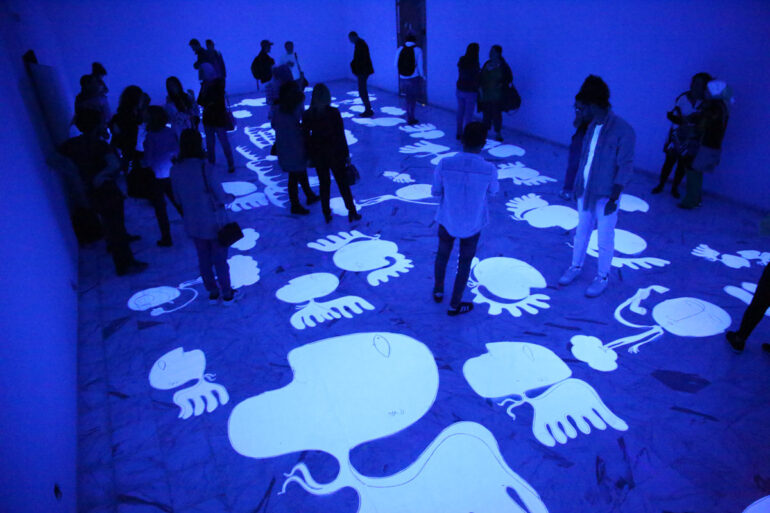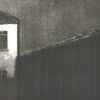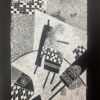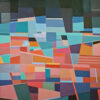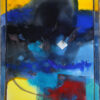

The critical mind stood bewildered when it came to
examining the situation of The Beautiful within the creative
experiences, when they no longer could be subjected to
the classic categorizations, or even the modern ones.
A beautiful thing is no longer the main purpose of art as it was in modern art. Postmodernism has posed many other challenges such as stimulating and sensitization by means of exposing, shock, mockery, and distortion… and those are activation agents to boost the human consciousness of the current historical issue. Some artists even go the extra mile distorting the world’s image to cast the spotlight on the residues of wars, and actively depict an unsound image of nature to stimulate ecological consciousness. Art is resistance; in a time where art is no longer about the self-emotions, which rely on art to share their aesthetical amusement (as it was in Immanuel Kant’s philosophy), but about generating knowledge, connecting the creative path to the life of the being (as it is in Edmond Couchot and Xavier Lumbart theories), and reviving the innovative mutual among human masses (As in Antonio Negri theory)… those represent shifts in thoughts, perceptions, and ways of interpreting and understanding the world. Such accelerating shifts laid the foundation for postmodernism, and it became a necessity to understand them in order to understand contemporary art phenomena and later ones… the concept became the soul focus of art, and thus the latter had become in constant need of a new definition and a new quiddity with every new artwork.
Our current intellectual crisis is more specifically conceptual and quiddative: What is art? Who is art audience? And more importantly what is intellect? What constitutes the right conditions of an artistic display and what is its essence? I.e. how to liberate art from the ancient concepts that go back to the middle ages or maybe the 18th at best? Also, can we, by updating those concepts, develop a legislative repertoire and derive institutions? And in the light of all of these, how are intellectual programs waived seamlessly? Restoring the link between intellect and knowledge constitutes the front line of this reformation battle, and without achieving that, the intellectual work will forever be relying on copying the primary raw techniques and skills which does not amount to the level where it can originate values and serve the creative spirit, and does not rise to a level where it can make meanings and produce the accumulated cultural discourse that can represent the society’s conscious. Today, art and knowledge are correlated, and now more than any time, art is linked to historical epistemology and innovative renovation in decentralized work frames built on innovative participation. This could be the title for every possible innovative citizenship awakening and an identification card for the country, it also serves as the first challenge for promoting, marketing, and radiating. It is beyond the naïve handling of the shocking updates on art concepts in the world, and beyond the abrupt folkloric minimalism that was associated with intellect in all Arab countries for decades to accommodate the foreign tourist and hinder the creativity of artists and those who construct the cultural landscape!
hus, the progress that blemishes art history has no meaning, at least for current times, without another progress going side by side affecting the terminological and conceptual apparatus related to arts, and their discourses and presence in the dialectic intellect. Any real piece of art produced today represents a revolution in the concept, and proposes a new definition for art. We could, just by considering the work of each of Joseph Kosuth (a key figure of Conceptual art), Pierre Soulages (a key figure associated with what he called “Outrenoir”), and Tunisian painter Néjib Belkhodja (one of the key figures of Abstractionism in the Arab World). Those are examples for us to realize the fact that in order to be an artist in this time is to re-pose the question about the quiddity of art. Art is not about embellishing the walls of lofts and museums, but to fight for life. Art is to rhyme, through history, with life’s beats, and to revive it with the living intellect that contributes to the body of knowledge and nourishes the intellectual consciousness.
1- In Narration of The Beautiful:
Even though art has long since been associated with beauty, modernism worked on providing this “beautiful art” with an identity, and enabled it to gain independence and domination. For that, it stopped being inherited and it longer is a fixed variable or a given order that the senses need to obey to adhere to the church’s rules or to the rules imposed by society and its norms… a beautiful thing doesn’t exist beyond the self-sensations, and it doesn’t exist on its own. A beautiful thing is regarded as beautiful because the Self has sensed it and saw it this way as Emanuel Kant, the German Aesthetics theorist, stated in the 18th century in his book “Critique of Judgment”.(1) Also, Baumgarten, Kant’s professor said that art provides us with eyes through which we can see the world, since he was meaning to make Aesthetics a topic for scientific knowledge, thus challenging Leibniz who saw that knowledge doesn’t exist outside the borders of Noeta.
The term “Beau Art” appeared back at the end of the 17th century, as stated by Jacques Lacombe in his Encyclopedia dedicated to art in 1752 AD. Baldine Saint Girns (2) identifies the 4 major events that set the perceptions of beautiful and ugly.

The first one was Autonomy of Beauty at the end of the 18th century, and it is worth mentioning here the efforts of Agostino Nifo in this field, as he was the first to grant “the beautiful” its dominance and independence in his book “Le livre du beau” in 1531 AD. Second, the efforts exerted since the renaissance to find a place for “the beautiful” in art. Third, placing “the beautiful” as the topic of intellectual discussion, for being a standard example. Fourth, the existing conflict in approaching “the beautiful” and “the ugly”.
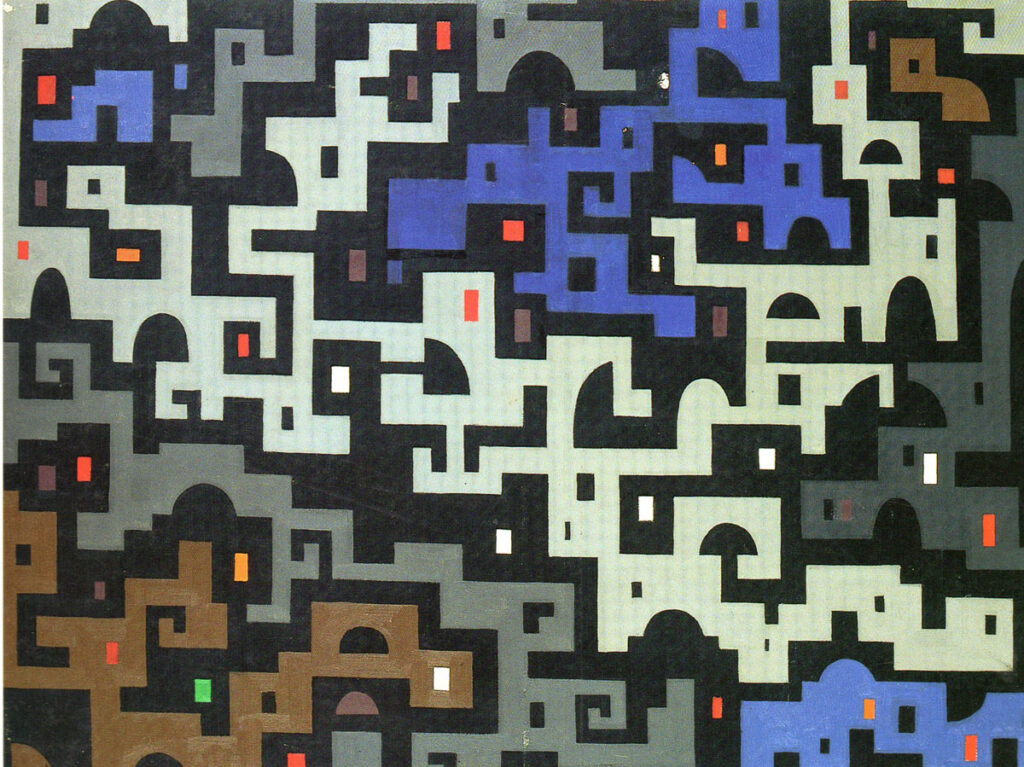
“The beautiful” was not without impurities, and those impurities came into question whenever a dialogue took place concerning its position within the cognitive systems and idealistic philosophy. It was a source of rejoicing and love, but at the same time, a source of disappointments and fallacies. However, the mystery and ambiguity surrounding “the beautiful” can be traced back to a situation where it loses its connection to the good “in ethics” and to the true “in knowledge”. This shows in Plato’s reservations in the Hippias Major dialogue, so “the beautiful” in visual arts is stained with some kind of inferiority on an ontological level, due to being associated with deception and fallacy. It is no more than “sensible shadows of the higher principle” according to Plotinus, another idealistic philosopher, in his “enneads”, as it is couldn’t be farther from the truth since it is established on the fallacies of sensory perceptions and their transcendences on which no form of intellect can be built!
The finest thing about the beautiful, in the ancient approaches, is that it indicates something other than what we perceive with our senses. Beauty wasn’t considered for its forms, but for its ability to sparkle an awakening of cognitive consciousness, to support wonder, and to act as a medium to approach the universe. The platonic metaphysics, as well as homogenous metaphysics, has distinguished between the substance and the accident; the Form and the Idea, the container and the content, the celestial constant and the earthly variable, the mortal and the immortal… The Beautiful had better detach from its varying, fallacious, irascible, and liquid properties and attach to wisdom so it could be a moment of a cognitive dialectic and reach the truth. Art here is no more than the reflection of the constant aesthetical constant that we can perceive through the mind, not with senses. This is how The Beautiful became associated with the idea, truth, and wisdom, as in “The Symposium” dialogue. Those are the same values that Nietzsche would revolt against to bring The Beautiful back to its variant nature, following the example of “Dionysus” in the ancient Greek myth. Dionysus was chosen to free The beautiful from the Platonic truth and from the ethical Kantianism load… carrying the early signals of postmodernism.

Resorting the link between art and idea would happen again in the 19th Century, with Hegel in specific in “The Idea of Beautiful” but within another idealistic philosophical context. “Art is the sensible incarnation of the idea”. It is as if the art form has remained subject to the superiority of cognitive epistemology over the aesthetical experience. Although the latter holds a “historical” property in the Hegelianism approach of art in addressing the “The Phenomenology of Mind”. Hegel will come to be the first one to declare art to be dead in exchange for the mind to be alive, and in exchange for the idea of aesthetics. These are the phases that The Beautiful experienced throughout history, and now, it has the chance again, at the height of modernism, to manifest intellectually and symbolically…
However, what matters the most for me to determine the value of an artwork displayed in front of me? Is it the philosopher’s idea, the artist’s perception, or the aesthetical relevance that intrigues me? Or is it maybe the happiness it promises me or the halo that promoters and institutions waive around it or could be the set of prejudgments that were assumed by the general population, when the concept of art is merely what people call art, the same way that Tiary Daudive describes in his book “For an Archaeology of Modernism, in the name of art”?
This question leads us to evaluate the status of The Beautiful today, amid those shifts of modalities and the changes in aesthetical judgments of the creative products. To what extent does the status of The Beautiful change with the shifts of the art-related concepts and the shifts in the quiddity of art itself or even with it fading? Furthermore, how plausible it is to continue approaching art through the quiddative issue, especially when it comes to postmodernism visions that derive their intellectual load from the Nietzscheism ideas, which rebelled against the standard judgmental systems, and which also blew up the paradigms and realigned the relationships within intellect with all of its values and gains beyond the certainties and with a nihilism inclination? What aesthetical presence can be hoped for in the light of those shifting paradigms in vision and in theory?
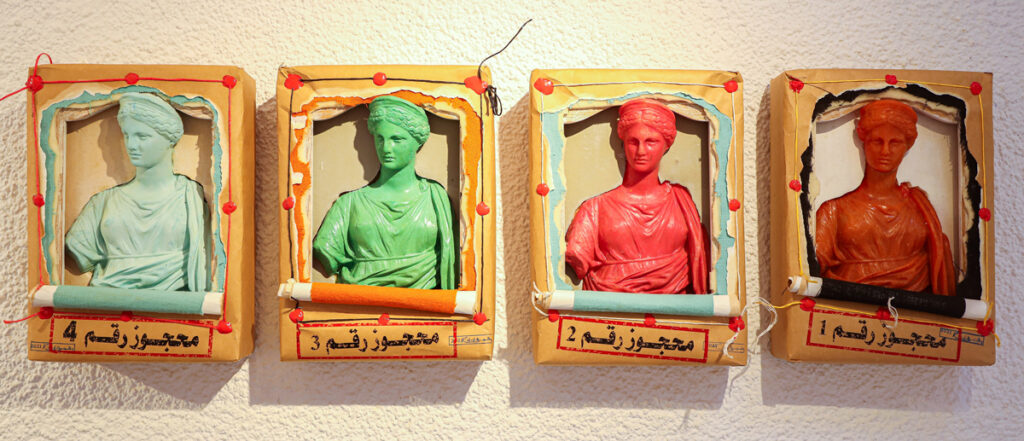
2- Against The Beautiful and its Representational Paradigms:
The critical mind stood bewildered when it came to examining the situation of The Beautiful within the creative experiences, when they no longer could be subjected to the classic categorizations, or even the modern ones. Given this situation, The beautiful is either no longer a required sensational need for humanity while dealing with art pieces, especially contemporary ones, and it is no longer an inspirational source for choosing, judging, and evaluating. Or the humanity concerns of today, after their detachment with the old system of value since their formation in the Greek philosophy at least, are seeking new values, those values should be more committed to addressing this troubled reality after it was burned with the political regressions, the globalized cultural curves, the biological catastrophes, and the climate changes, which shadow the ecological thought burdens. Those values are no longer appealing to the external properties of The Beautiful. This is because, on one hand, they reflect a state of deep-rooted concern, and aspire to an eager restoration of the vibrant life, humanity of humans, city-like features of the city, and the natural features of nature. This is at the times of terrorism and pandemic terror, the time of entropy and endangered biodiversity, the time of political chaos and presumptuous decisions, a time we’re witnessing the objectification of values, commodification, and marketing of “disorientation”… given what the current artists are introducing in the fields of “Land Art”, “BioArt”, “Ecological art”, “Virtual Art”, and “Net Art”… art is not necessarily beautiful any more as much as it is shocking and sensational, even if it required to destroy the standardization of The Beautiful, and rebel against the conventional concept of The Beautiful, and even taking the extra mile to distort the world’s image, if that’s what’s needed to publicize the problematic areas and point a finger towards the aggravated human condition. It is enough for art today to be the defender of life of being, remind us of the genius of nature, and be the guide of humanity so we can reach more appropriate considerations of free-living and effective residence on earth. It is true indeed that humans were the first beings to destroy the dynamism of life and the values of freedom in their quest for continuous development. The technical and instrumental mentality has enlarged to the extent of alienation, within a vortex of irresponsible consumption, while the conditions of natural existence are being destroyed! In this manner, art starts to abandon the beauty value, and it is a continuation of what Hegel proposed in relation to “self-destruction”, which humans are practicing passionately while immersing in the modernism experience, worse still, it extended to confer postmodernity in particular.
Modernism has worked on attributing the sense of beauty away from the dogmatic standard closed paradigms, those that are old and medieval, when beauty had set standards and was imposed by the absolute thought, rather than it being proposed by the sensible sense and the creative culture that has this formulated-self, philosophically since Baumgarten, and artistically since the emergence of Impressionism movement with Claude Monet.

Modern art has reconstructed the image of the self, and made it the standard legislating source for the values of The Beautiful while the postmodernist experiences today are going in another direction as they are trying to fuse the selfness of the artwork in the furnace of the real live battle and the social artistic epistemology. Art allows incarnating the sayings of collective participation in the daily living space or the interactive virtual. The creative self is giving up its unique golden throne, and moving away from the centrality of the creative vision in perceiving the artwork, executing it, and showcasing it, and away from the technical arrangement and the complex aesthetic. That is because the human and social event that might strike an interest, like the scream of a Palestinian kid under the debris, needs finessing in order to pass to the artistic realm. As in Raouf Karrai’s words, or as in the struggle of an Iraqi man who was burdened with travel and departure searching for an adequate concept for home land, in the standard performance of Sameer Majeed al-Bayati, which was transformed by Mawledi Izz Al-Deni into a discourse on the significations of ever traveling and estranged existence. It is a call for freedom at times of siege, relying on philosophical references for reading and analyzing, such as Nietzsche, Hegel, and Heidegger, exposing what he called trivializing the truth because “when one feels the coming to an end, in matter, in soul, in land, in being, in city, or in home land, he is to resort to the last territories of his artistic creativity, searching for what could be the real meaning of the city”. (3) In many examples, it is enough to transfer the form of the live realistic phenomenon to a museum, to display space, or display it in the public space, according to what the elements of the display and its artifacts offer. Until it could turn into a topic for examination, interpretation, and textual critical culmination, and so that it could be continued in the form of what we call “becoming text”, and it is an advanced stage of constructing the work of art.
We’re no longer speaking of the representation of something, but rather the presentation of it when it becomes a topic for showcase and interpretation. It is the same idea that Loic Fel’s “Green Aesthetics” book revolved around, so the role of the maker and the artist declines and their presence fades in favor of a “direct aesthetical relationship between the self and the nature topic”. (4) Artists have managed to present things from our daily life surroundings and might make amendments to them.
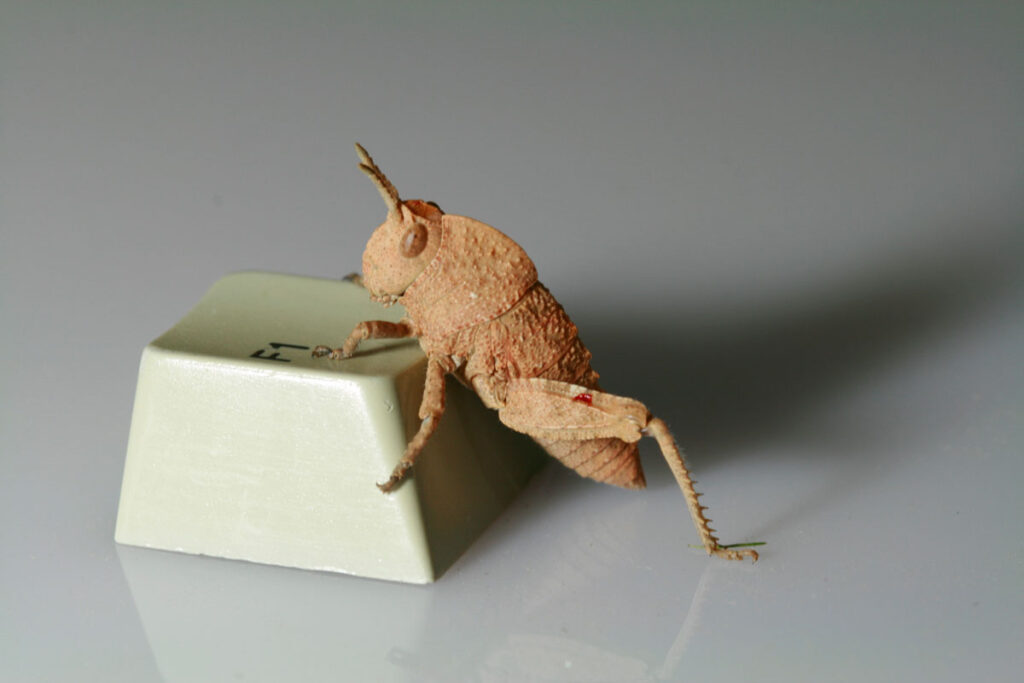
From Marcel Duchamp’s Urinal, and the Spiral Jetty of Robert Smithson, to Christ’s Wrapped Building… we could also see, in the recent passing years, various experiments here and there in the bio-art field. Examples of those experiments would be Eduardo Kac’s Mutant Bunny, and Amine Elgheryeni and his olive tree; the multi-colored Bonsai tree injected with natural coloring materials, which was a collaboration between art and the laboratories in the universities of Toulouse, Sfax, and then Cabès (5) under the name “Biolivart. We can see in Morocco some experiences using different techniques by Kenza Benjelloun, and Rim Laabi in UAE, with Hassan Sharif and his art installations in which he collects materials and usable objects from daily life. Or with Karima Al-Shomely and Khalid Al-Banna who produced the visual mark out of the painting frame so it could gain independence by themselves within the display space. From Libya, we also see the career of Adnan Meatek who liberated his figures from the representational space and made question marks out of them. In the time of war contradictories, or with the Syrian artist, Talal Moualla, who eliminated all the beauty features of his figures, and portrayed them as problematic screaming marks that provoke the viewer and invoke the underlying existential crisis in their anatomical imbalances. In Tunisia, we also see the experiences of Faten Chouba Skhiri, Nour Houda Mhiri, Wadi Mhiri, and Mouna Jemal Siala, in the field of re-building the living space and charging it with critical significations by a set of art installations. Also, the experience of Agglutination by Mohamed Rekik in which he addressed the topic of restricted mails and prohibited postal packages, or Anis Ben Salem who utilized the elements of mirrors and pictures collages in interactive topics related to the live constructional places and he benefited from his specialty in audio-visual arts. Other examples could be Burhan Bin Oribia and Ghada Bouzguenda and the (in-situ) art, where they re-raised the question of the structuralism of the city and correcting the image of the individual in the time of globalization and historical reversal, or Helmi Jribi who dealt with photographic techniques in the field of macrocosm and utilizing insects to create a set of sarcastic whispers and winks, or Wissam Al Abed with his show “travelers” in which he used signification to speak of the secretive immigration via the sea, he scattered his lost and immigrant figures among the show visitors using black lights, which turned into blue color when the floors were immersed, where there was a symbolic overlap between the traveling figures and their remnants among the visiting audience. So are such displayed “objects”, “beings”, “entities”, “atmospheres”, or “cases” deviated from the concept of artwork? Furthermore, according to François Lyotard, one of the postmodernist philosophers, postmodernist art disclaims the concept of the artwork that was established by the traditions in art history and aesthetical thinking.(6) Lyotard even goes further to describe postmodernist artwork as the art that introduces “the unpresentable”, thus conveying the idea of the “negative presenting” or “absent presenting” and accepting just the mere notion or hint of it. (7) “The postmodernist artwork always seems to be rebelling against the already set artistic traditions, trying to violate them and break them, which is why it could be described as “ugly”… it is constantly attempting to break the rules of The Beautiful that are commonly agreed upon among the audience, so that it seems, in many cases, ugly. Yet, this ugliness plays a more vital role in postmodernism aesthetics, which are in reality “Anti-aesthetics”. Such aesthetics, in their portraying of the sublime, they are mean to rupture the work of art, and deny the unity and harmony.” (8)

Reproduction was no longer a scandal since it was encouraged by the avant-gardes at the beginning of the 20th century, also since what Walter Benjamin, a member of the German Frankfurt School, stated in his book titled “The Work of Art in the Age of Mechanical Reproduction” (written in 1935) “In the contemporary art, of consumable tendency, the reproduction replaced the reality, the hyperreality replaced reality itself, the human in the age of postmodernism, is living what he lived before, which was reproduced with no additions, even if it seemed like a disambiguated machine” which comes in line with the phenomena of virtual arts and hybrid arts, where artists, engineers, and biologists master the act of innovating other fields to compensate for the realistic feature of the reality, so close to reduction and hybrid, and away from the living phenomenological linkages that were called for, some way or another, by the green aesthetics in approaching the living world. The concept even has swallowed the material and sensible subject, and art now resorts to residing in the logical perception which lies in language, and it is no longer in need of the sensible image, as in conceptual art. Kosuth’s opinions lead us to think that “the philosophy that dealt with beauty and taste had to discuss art, and this is a misconception that art and beauty are correlated conceptually, and this is not true… this is how Kosuth put down conceptual art against the conventional ideas of beauty, with the intention to liberate art from the patterns and methods associated with it throughout history.(10)
3- The Concept Departure from the Visual form to the Linguistic Intellect and the Epistemological Challenge (From Image to Perception)
In the editorial of “Art & Language” magazine issue of May 1969, Terry Atkinson, member of the editorial board, discussed Joseph Kosuth, the conceptual artist. He emphasized the importance of considering a work of art from the angle of its visual identity, with a focus on what he called visual independence, stating it as an ontological principle that is required for the artwork to exist in itself, regardless of how far theorists go in their continuous attempts to determine the quiddity of art, in a renewed approach. Atkinson’s attitude comes along with the approaches I’m willing to utilize to reposition conceptual arts and reevaluate its gains at the time, by focusing on “the visual role and rectifying the abstract (mental) feature of the conceptual thought” (paragraph 14 of the editorial). Yet, the author concludes his essay by bringing up the open nature of art again, and the possibility to invest it within linguistic purposes as a basis for his experiments and research. The same approach was adapted by Analytic Anglo-Saxon Philosophers, who became the center of contemporary art theory in America, while they were originally logical philosophers. They owe it to the research of Wittgenstein, the German philosopher, who wrote on logic and was open to aesthetical linguistics, same as Arthur Danto. They have positioned the contemporary work of art within the logical lingual matters. So the “chair” concept for Kosuth, and its linguistic definition, is far more important than the chair that is laying in the museum, and more important than his picture hung above it. In the same way, Kuriloff, the American artist, and the title of his work “Laundry Bag” is far more important than the work itself, which is indeed a laundry bag. Andy Warhol, with his famous piece “Brillo Boxes” which was displayed in the museum since 1964, cared more about the title of it, more than about the Brillo and the boxes displayed in stores…(11)
We’re currently against what we can call skeptic and critical modernism. Domitry Kikan states in his book “The Human in Posthumanism”: we might be allowed to speak of having some sort of positive postmodernism, which is inclined toward accepting the theory, more than rejecting it. then we might speak of: a skeptic doubtful postmodernism that does not dismiss the theory and the concepts, but rather put them through deep critical analysis, before deciding of whether they are true or not” (12)
With the emergence of new technologies, which revolutionized image and perception in approaching the world and interpreting it, we no longer look at reality except from the angle of digital virtual reality! According to Jean Baudrillard, virtual reality has substituted real reality, and the borders between real and imagined, truth and lies, the genuine and the simulated(13)… are overlapping. The waves of postmodernism have declared the “Death of Art”, and now they’re declaring the “Death of Reality” with passion. We’re now addressing the world identity as hypothesized perception, or a virtual image, in which humans’ “humanism” are alienated, and it longer possesses its natural nature or vivid life… some counter-movements emerged, and invited to bring back the artistic consciousness to the “embodiment” of the lived world, as it is, far from the simulated representations, thus restoring the vivid phenomenological question through art. So “are computers capable of engineering our raw natural identity, and satisfying our most intimate needs of the vividness of nature, with its eternal pulse and innovative permanence?”(14)
Modernism has worked on attributing the sense of beauty away from the dogmatic standard closed paradigms, those that are old and medieval, when beauty had set standards and was imposed by the absolute thought, rather than it being proposed by the sensible sense and the creative culture that has this formulated-self, philosophically since Baumgarten, and artistically since the emergence of Impressionism movement with Claude Monet. Modern art has reconstructed the image of the self, and made it the standard legislating source for the values of The Beautiful. Conversely, the postmodernist experiences today are going in another direction as they are trying to fuse the selfness of the artwork in the furnace of the real live battle and the social artistic epistemology. Art allows incarnating the sayings of collective participation in the daily living space or the interactive virtual. The creative self is giving up its unique golden throne, and moving away from the centrality of the creative vision in perceiving the artwork, executing it, and showcasing it, and away from the technical arrangement and the complex aesthetic. That is because the human and social event that might strike an interest, like the scream of a Palestinian kid under the debris, needs finessing in order to pass to the artistic realm. According to Robert Smithson, the pioneer in Land Art, nothing needs changing or a new direction for nature to turn into art(15)… yet, art has to get the inspiration for creativity from the pattern of the natural being and the genius of life with all its biological systems. It should not be a mere simulation of nature and a capture of the transformation process, as demonstrated in the research of Edmond Couchot and Xavier Lambert.(16)
While art was still defined as “generating beauty by a conscious being”(17) according to André Lalande in his Technical and Critical Vocabulary book (1926), beauty is no longer interconnected with art quiddity or Ontology. The art form has defied its set frame and became a stimulating element of the daily and communicative spaces.

Moreover, artwork has become a protesting and a sensitizing power, cynical and outspoken, exposing contradictions and active in public matters and public space; distorting, simulating, and striking… With this, the presence of The Beautiful shrinks and declines with the changes in the purposes of the artwork, while pledging itself to the current issues of humanity and keeping track of historic events concerning the public conscious. Art was no longer just a mere individual emotion out in a distant corner of an artist’s studio, with a view of the sea flirting with the whispers of the waves, or a view of the mountain where the scents of the trees and the fragrances of the flowers, or maybe to a unique view to the Seine river in Paris where the colors are mixed with the blueness of the water and the surrounding architectural patterns, the same way with the impressionist artists… it is instead a lived instance, and an experience in the vivid history breathing life into the social, political, and ecological consciousness. Apart from beautifying, art has embraced the ugliness of reality. It carried intriguing and striking events, and bore the burdens of continuous war against the primitive and surficial conscious of objects and events. Thus, the artists keep on tearing the familiar horizon of waiting, and the different conventional beauty standards. In contemporary art, there is nothing worthy to be conventional. This comes in line with the existential rule “do whatever you want, as long as it is new” and as long as it is shocking. Therefore, the beautiful loses its old and modern position, and it suffices to become a training course in art academies and art clubs. While the beautiful topics in the contemporary “world of art” have become heavy burdens, calling for mockery, and revealing a kind of naivety when proposed, examples of that would be the “vase”, “still landscapes”, and “sunset”… which are usually approached by amateurs in art practice, and they’ve become an area for professional photographers.
The institutions in our countries continue to use the name “Higher Institutions of Fine Arts” while many of the countries pioneering in this field hold the name “Higher Institutions of Art”, keeping the term “fine arts” to indicate the academic aspects that don’t really fit in higher education institutions such as the foundations of classic and modern art, especially those related to linear paintings and interrelated topics such as Anatomy and Perspective. The cultural institutions adopted in our countries, with their Legislative repertoire, still rely on ancient worn-out concepts of art that are not related to the current art movements. This is apparent on cultural and educational fronts, let alone media programs as the media discourse is still governed by the ancient concepts of art and artists, distant from the renewal and creative qualities, and even detached from art history. For that, a terminological revolution is called for, one that includes the artistic conceptual tools and is capable of restoring the defining characteristics of artwork.
***
This has led us to reconsider the conceptual and values shifts that accompanied art, aesthetics, and modernism and postmodernism approaches throughout their history, as the quiddity of art has faced problematic shakes. This has encouraged us to further observe dialectic intellect models and resort to the interpreting method to understand the world.
In brief, art has an extended history that has always resented stagnation and has always rebelled against itself. During such history, the art and critical practices have witnessed shocking developments related to concepts and terminology. Those developments reflect the extent to which art quiddity itself has changed, so it became frivolous to even try to find a confined quiddity for art. For that, we can say that art today acts with no quiddity at all! Producing The Beautiful is no longer the purpose of art, even if its presence was established in many art experiences. Plus, as Farouq Youssef states “one of the properties of real artwork is their resistance to the audience’s capability to consume them”
Modernism and postmodernism have posed the fact that modernizing is a comprehensive movement, and art cannot be marginalized. Real art practices refuse to be on the side of the intellectual movement in history.
They cannot but fight at the center of the battlefield. They take an intellectual stand while trying to interpret, overpass, and generate new values, constantly. Those values differ based on the angle from which they see the world, as they could be depicting intellectual creations at times, maybe using technology in some of them, or could be, at other times, deriving them from the reality here on earth and the challenges of existence. Reverting to The Beautiful in a new form is always an option and is still possible but only within the frames that are allowed by the vital and innovative life. Art today, under the umbrella of a globalized civilization, has to rectify humanity’s deviation from the logic of life and the norms of existing in a possible world. It also has to resist the mortal tendencies and the ever-lasting endings (The end of art, history, and humankind). Art, indeed, still has missions and challenges to overcome, but should also, “Immunize existence against falling into the void” according to Umm Al Zein Bin Shikha, in describing Antonio Negri’s position.(18)

Art is not about painting the different forms of life, but about bringing shapes to life after they were long forgotten, worn by consumption, and frozen by civilizations. For that, we’re yet looking…
1. Kant (Emanuel) : Critique de la Faculté de Juger. Trad. Alexandre J.-L. Delmarre ] et al.[Ed. Gallimard, Folio-Essais, Paris, 1993, p. 149.
2. Saint Girns (Baldine) : Encyclopædia Universalis, article : Beau/Laid, arts, Paris, 2012, p. 222.
3. Izz Al-Deni (Mawledi) The Coherence between the Ontology and the Political in The Artistic Impact, The Being of The Artist and The Question of Homelands, introduced by Khelil Gouia, Khoto Wa Zelal Publication House, Amman, Jordan, 2021, page 186 (In Arabic)
4. Fel (Loic) : L’Esthétique Verte, de la Représentation à la Présentation de la Nature. Edt. Champ Vallon, Paris, 2009, p. 232.
5. Elgherieni (Amine) : Bio-art and the Environnement, Complexity within Interconnectedness, preface by Xavier Lambert. Cambridge, 2021.
6. Lyotard (Jean-François) : Lessons on the Analytic of the Sublime. Edt. Stanford Univ. Press, 1994, p. 68.
7. Al Baghdadi (Khalid Mohammad): The Trends of Criticism in Postmodernism Arts. General Egyptian Book Organization. Cairo, 2008, page 79.
8. Ibid, page 72
9. Ibid, page 76.
10. Amhaz (Mahmoud): Contemporary Fine Art, Al Muthalat Publication House, Beirut, 1981, page 298, mentioned by Al Baghdadi (Khalid Mohammad): The Trends of Criticism in Postmodernism Arts. Previous reference, page 268-269, (In Arabic)).
11. Voir Danto (Arthur) : La Transfiguration du Banal, Une Philosophie de l’Art. Trad. Claude Hary- Schaeffer, préface de : Jean-Marie Schaeffer. Edt. Seuil, Paris, 1989, pp. 213-218.
12. Kikan (Domitry), The Human in Posthumanism, introduced and reviewed by Omar Abdulaziz, Department of Culture, Sharjah Government, 2008, page 73, (In Arabic)
13. Al-Aydi (Salwa): “Mutuality in Visual Arts: Horizons and Borders. A Reading of Contemporary Experiments” in The Mutuality of Construction via New Technologies, a scientific national peer-reviewed seminar, Commissariat Régional à la Culture de Sfax publications, 2021, page 60. (In Arabic)
14. Gouia (Khelil): “Artistic Investment of the Virtual Image and Technology of Deception” The Mutuality of Construction via New Technologies, previous source, page 53. (In Arabic)
15. Smithson (Robert) : « Rien ne doit changer pour que la nature se transpose en art », voir : The Collected Writing. Edt. University of California Press, 1996.
16. Couchot (Edmend) & Lambert (Xavier) : Les Processus de Réception et de Création des Œuvres d’Art, Approche à la première et à la Troisième Personne. Edt. L’Harmattant (Ouverture philosophique), Paris, 2016, p. 10.
17. Lalande (André) : Vocabulaire Technique et Critique de la Philosophie. Edt. Presse Universitaire de France (PUF), 16ème édition, 1988, article Art, sens A et B, pp. 79-78.
18. Bin Shikha Al Maskini (Umm Al Zein): Art Departing its Context or the Aesthetics of the Fabulous from Kant to Derrida, previous source, page 289.
Prof. Khélil GOUIA holds a Ph.D. in Art sciences and Techniques/ specializing in contemporary art, hes is a researcher, artist, & Professor of art theories and semiology at the University of Sfax, Tunisia. He is awarded Shiekh Zayed Book Awards, Abu Dhabi International Book Fair, 2021, UAE. He is the chief editor of “Founoun” magazine, which is published by Ministry of Culture, Tunisia, since the beginning of 2013.

